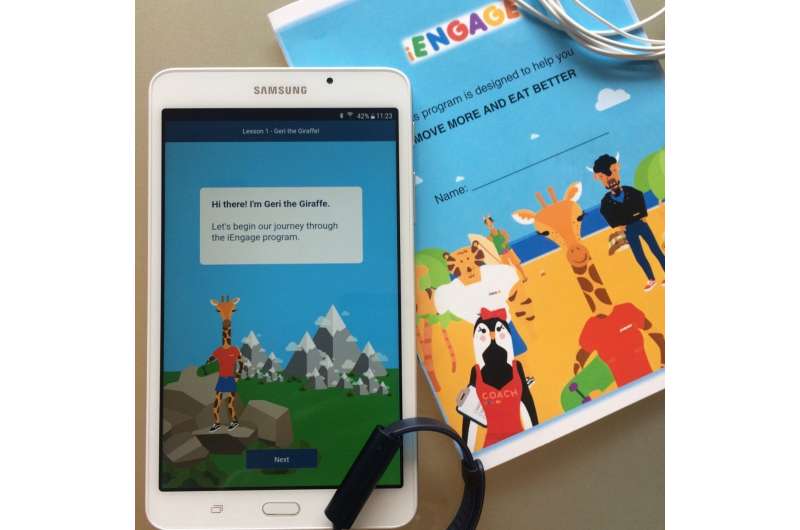This article has been reviewed according to Science X's editorial process and policies. Editors have highlighted the following attributes while ensuring the content's credibility:
fact-checked
peer-reviewed publication
trusted source
proofread
Digital program gets school kids moving

Every parent worries about how much time their child spends on screens, but what if screens could also provide the answer to growing levels of inactivity in Australian kids?
Sydney school kids participating in an innovative program developed by researchers at the University of Sydney increased their daily step count by 30%, while learning how to set goals and understand different levels of physical activity.
The research team say it is vital something is done to combat children's inactivity and digital technology could be part of the solution.
The iEngage program used a combination of wrist-worn activity trackers and a specially designed online reward-based health education and behavior change app, developed in partnership with Alira Health.
The five-week program was run with small classes of 10- to 12-year-olds in two Sydney schools and helped students to understand and set physical activity goals, track progress and increase their levels of more vigorous or "huff and puff" exercise.
The results of the study are published in PLOS One.
Lead author Professor Corinne Caillaud from the University of Sydney's Charles Perkins Center and Faculty of Medicine and Health said growing rates of obesity in young Australians are a cause for concern and that innovation is drastically needed.
"We know only around 20% of 5- to 17-year-old Australians meet the recommended 60 minutes of moderate to vigorous physical activity each day, and we haven't seen any improvement in 10 years despite numerous public health campaigns and interventions.
"Wrist-worn devices and activity apps are popular with both parents and kids, but purely tracking activity or pushing information at children doesn't bring about behavior change.
"iEngage is unique as it is based on the latest scientific evidence. The program is specifically designed for adolescents, and is mapped to the Australian Physical Literacy Framework, to give young people the skills, knowledge and behaviors they need to live active lives."
Professor Caillaud said another important element of the program is that it isn't purely based on the child's physical abilities.
"Participants can also win rewards and progress based solely on knowledge which gives it a wider appeal and makes it more inclusive for all children," she said.
"We focused on creating a digital interface for children that supported experiential learning through the integration of physical activity and health education with data from activity trackers," added Gaël Clerc, VP, Head of Product Line b.research–Clinical Research Solutions.
"Our digital platform enabled self-paced progression of knowledge and skills, facilitating physical activity behavior change. While developing the app, it was crucial for us to ensure we addressed the needs of this specific group of adolescents and to design a user-friendly and engaging digital environment."
About the iEngage program
The program comprises ten 60-minute learning modules and is delivered via an app available on tablets, combined with a wrist-worn activity tracker.
Activities included peer learning, physical activity, body movements, learning about sugar in drinks and food, simple calculations and readings delivered in a way that helped children develop health, digital and physical literacies at the same time.
Key results from the program
- Adolescents successfully set goals and self-assessed achievements
- Boys increased their goals and achievements faster than girls
- Participants saw an overall 30% increase in daily steps
- Consistency in days totalling at least 11,000 steps increased from 35% to 48% at the end of the program
- In the week after the program, (compared to the control group) participants increased their moderate to vigorous physical activity by five minutes per day, particularly in short bouts during lunchtime, recess and after school.
An important data source
iEngage also provides researchers with a wealth of real-time data regarding young adolescents' physical activity and the impact of introducing different educational materials.
Professor Caillaud and the team hope to consolidate the partnership with Alira Health through new funding and to continue working in collaboration with schools, teachers, and children to develop the program.
One future direction for iEngage is to detect meaningful changes from tracker data and to co-design with users automated feedback encouraging the formation of new behaviors and habits.
More information: Corinne Caillaud et al, iEngage: A digital health education program designed to enhance physical activity in young adolescents, PLOS ONE (2022). DOI: 10.1371/journal.pone.0274644




















